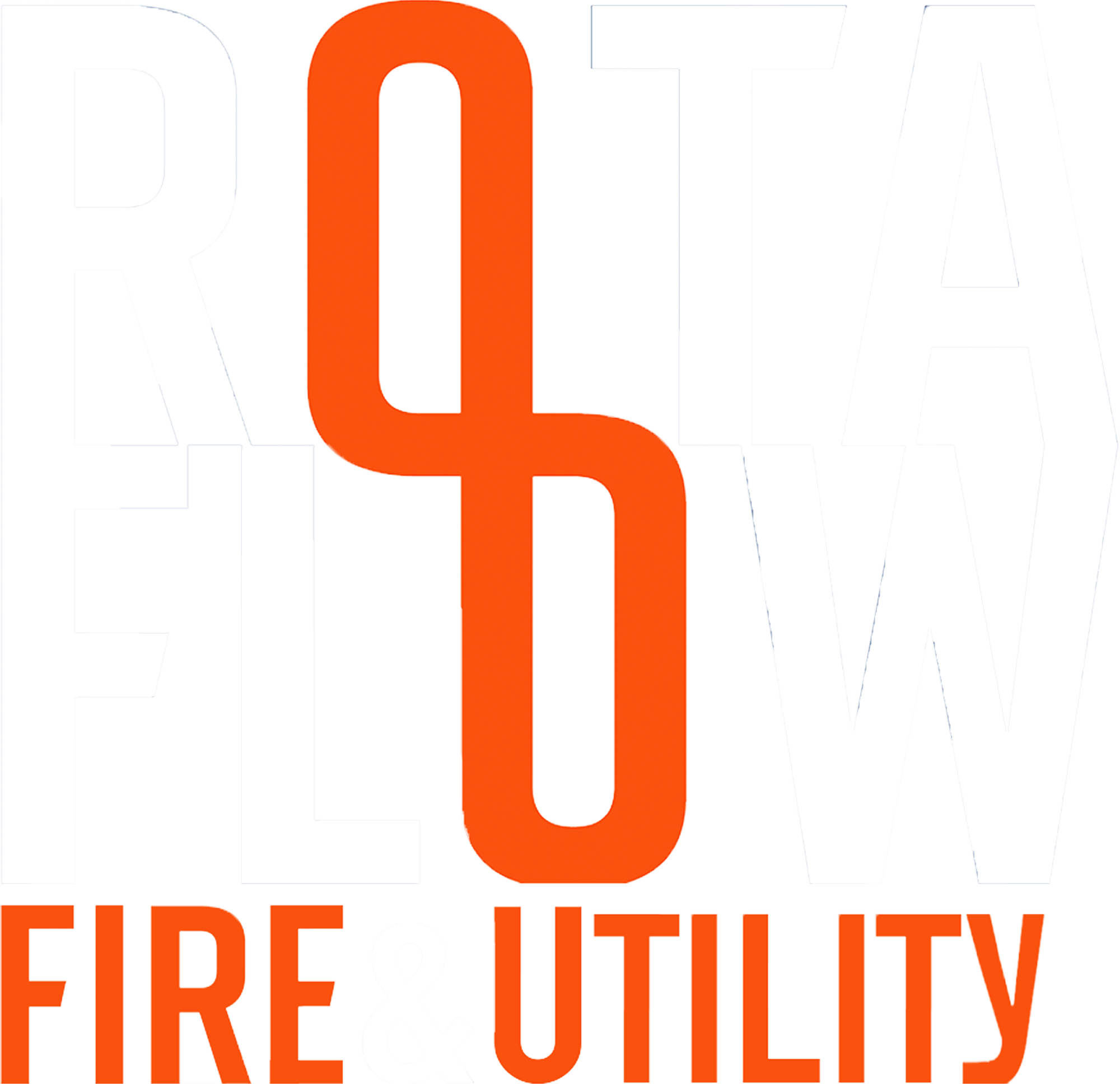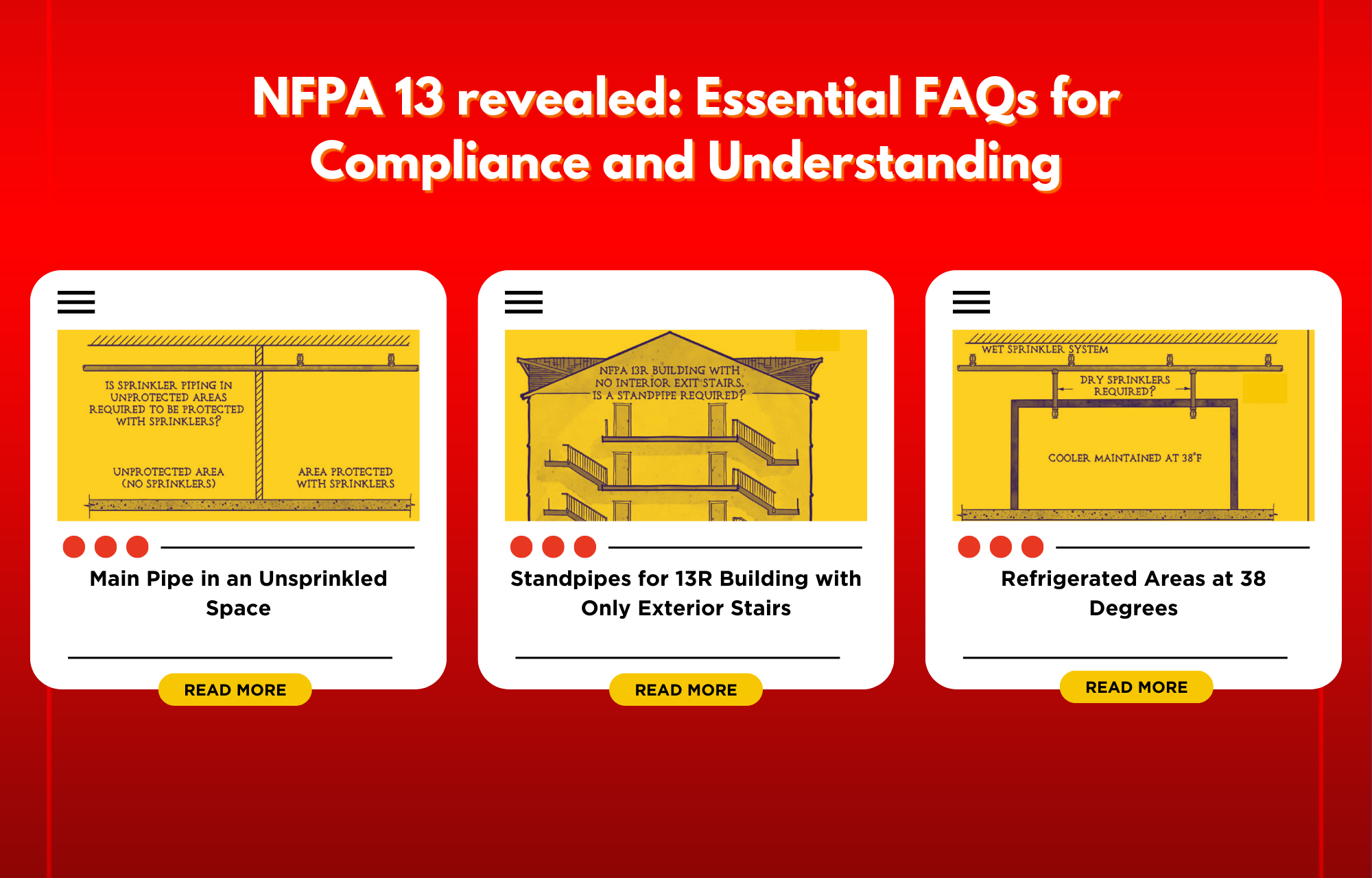Summary: The FAQs cover a wide range of circumstances and complexities relating to NFPA 13 and other applicable codes. They address issues such as piping location in unsprinkled spaces, antifreeze usage, fire system classifications for residential buildings, sprinkler system capabilities, testing requirements for deluge systems, standpipe requirements in specific structures, and the use of remote-controlled valves.
The FAQs also cover the intricacies of concealed sprinklers, ceiling height constraints for sprinkler omission in light dangers, changes in storage protection standards, system monitoring requirements, and concerns for putting wet drops in chilled rooms. Each question includes thorough answers, citations to relevant code parts, and interpretations to help clear up various circumstances and compliance difficulties. This thorough compilation intends to provide experts negotiating fire protection regulations and NFPA 13 principles in various building and system design scenarios with practical insights and interpretations.
1. Main Pipe in an Unsprinkled Space. Description- An old unsprinklered building is being refurbished, and a variance has been granted to cover only two small residential areas with the 2010 edition of NFPA 13R. Water will be delivered into the structure from over 300 feet away from the parts to be protected. Question 1. Is it considered ``hazardous`` for the sprinkler main to go through unprotected regions, and are sprinklers required to protect this piping?
Answer: It is conditional. According to Section 8.16.4.3 of the 2010 edition of NFPA 13R, private service main above ground plumbing is permitted to be in a hazardous location when protected by an automatic sprinkler system. This clause only applies if the pipe is being run through a hazardous region. An automatic sprinkler system must be in place to protect the space if the piping crosses through a “hazardous area” at any point along the unprotected area.
The identical specifications are included in NFPA 13, and according to the 13 annex, any “area, structure, or building that poses a degree of hazard greater than that normal to the general occupancy of the building or structure.” These consist of heat-producing devices, toxics, flammable materials, and poisonous or corrosive substances.”
The sprinkler piping must still be secured against mechanical damage, but there is no requirement to protect it from fire using sprinklers if it does not pass through a hazardous area. If there are no sprinklers in the area, someone has previously used them.
It can be concluded that a fire in the space is not intended to be controlled by sprinklers. The worst-case scenario for a fire starting in this location is that it causes the main to fail and water to leak.

2. Darcy-Weisbach and Listed Antifreeze. Description- The Darcy-Weisbach Formula is required by NFPA 13 for antifreeze systems larger than 40 gallons. However, according to the new UL (Underwriters Laboratory) specified antifreeze cutsheets, the Darcy-Weisbach Formula should be utilized regardless of size. Question 2. Is it necessary to use the Darcy-Weisbach method when utilizing the newly listed antifreeze solutions if the total capacity of the antifreeze is less than 40 gallons?
Answer: Yes. There are now four antifreeze products on the market: Tyco LFP, Tyco LFP+, Noble Eliminator 1330, and Lubrizol Freezemaster. In terms of hydraulic calculations, the product sheets are practically identical, saying that the antifreeze friction loss is calculated using the Darcy-Weisbach formula regardless of system size.
NFPA 13 does include language that exempts systems containing less than 40 gallons of antifreeze. However, when the antifreeze product listing states that the Darcy-Weisbach formula for friction loss is to be used without a volume restriction, it becomes necessary, regardless of what the installation standard allows. As a result, the necessity for all systems to use Darcy-Weisbach is part of the UL Listing Standards. The products must be used in compliance with the listing standards, which, in this case, supersede the requirements of NFPA 13.
3. NFPA 13R vs NFPA 13D System Multipurpose Piping System. Description- A fire sprinkler system will be installed in a two-story residential building with nine apartments. The facility will be built in line with the International Residential Code (IRC) of 2018. Question 3 (a). Is it possible for a fire code official to grant a waiver from a 13R system to a 13D system for the mentioned building?
Answer: The answer is no, based on the information provided. The structure in question is a two-story residential apartment building with nine one-bedroom flats.
The NFPA 13D does not apply to this structure because it only covers “one- and two-family dwellings and manufactured homes.” The specified multi-family construction does not appear to meet this requirement.
Furthermore, it was indicated that this facility will be developed in line with the 2018 International Residential Code; however, based on the description, this structure does not appear to be covered by the residential code (see R101.2).
Section 903.2.8 of the 2018 International Building Code states that NFPA 13D systems are permissible in Group R-3, Group R-4, Condition 1, and small care facilities. There is insufficient evidence to determine if these classifications apply to the building in issue.
Question 3 (b). Is it permissible to use multipurpose piping systems in accordance with NFPA 13R?
Answer: No, only NFPA 13D covers multipurpose systems. NFPA 13R makes no mention of this system type, and while it is not expressly forbidden, multipurpose systems are not covered by this standard. It should be noted that, as stated in Section 9.6 of the 2016 version of NFPA 13R, common domestic/fire mains are permitted.
4. 2-Hour Rated Enclosure. Description- This topic concerns whether the capabilities of this particular sprinkler system are compatible with the fire resistance standards for the room's above structure. Question 4. Would an extra hazard category 1 (EH1) ceiling sprinkler system give the 2-hour rating for the roof/ceiling in a 2-hour rated room?
Answer: No, an extra hazard category 1 sprinkler system would not be regarded as an alternative to a 2-hour fire resistive assembly. The building code mandates that fire-resistant assemblies be tested in line with ASTM E119 (American Society for Testing and Materials). The ASTM E119 standard outlines the materials that go into a 1-hour, 2-hour, 3-hour, and so on fire rated assembly. According to the ASTM E119 test, one layer of 5/8 inch Type X gypsum meets a 1-hour fire resistive installation.
When sprinklers are present, the building code frequently provides a 1-hour reduction in the hourly fire resistance rating (2-hour down to 1-hour, for example). However, the presence of an EH1-rated fire sprinkler system does not correspond to a 2-hour horizontal fire barrier (or fire wall) rating.
5. Air Testing of Deluge Systems. Description- Annual full flow trip tests are required by NFPA 25 for deluge systems. Question 5. Is it permissible to substitute an air test for the wet test required by NFPA 13?
Answer: No, an air test is not an appropriate substitute for a full flow trip test on deluge systems. According to Section 13.4.4.2.3 of NFPA 25, deluge systems must undergo an annual full flow trip test. Section 13.4.4.2.3.1 allows for other testing methods when water damage is possible, but Section 13.4.4.2.3.3 states that a full flow trip test should not last more than three years.
Because of the surroundings that deluge systems normally protect, full flow trip assessments of deluge systems are performed more frequently than preaction and dry systems. The possibility of debris entering the system through open sprinklers or nozzles raises the possibility of blockages.
When testing a deluge system, a gauge at the furthest distant nozzle or sprinkler must be used to compare pressures with the gauge at the deluge system. This is done to see whether there are any obstructions in the system and to ensure that the nozzles or sprinklers are properly aligned. This cannot be accomplished effectively with just air.
6. Standpipes for 13R Building with Only Exterior Stairs. Description- Standpipes are needed for structures of four floors or more in the 2018 edition of the International Building Code (IBC). IBC Section 905.4 specifies the hose valve locations for a Class 1 standpipe. Question 6. Is a standpipe still required in an NFPA 13R structure with just external exit stairs, no interior exit stairs, and no additional mandatory hose valve locations?
Answer: No. The International Building Code (IBC) specifies the location of standpipe hose connecting points. The 2018 IBC requires standpipe hose connections in all interior escape stairways, which is a building code phrase. By definition, an interior exit stairway (enclosure) differs from an exterior exit stairway, and only standpipes are required on internal exit stairways per Section 905.4. This modification was unintended and is present in the 2018 and 2021 IBC editions, with the necessity for interior and outdoor exit staircases returning in the 2024 IBC edition.
The outdoor steps are exempt from hose connections in all cases with the 2018 and 2021 versions of the IBC, but be careful to check the rest of the section for additional hose connection locations. Check local ordinances for any changes to Section 905.4 that may necessitate hose hookups.

7. Maximum Ceiling Height. Description- This question requests clarification on any stated threshold in these fire protection guidelines for ceiling height exemptions for sprinkler installation in light-hazard zones. Question 7. Is there a ceiling height limit for light hazards that would allow sprinklers to be omitted?
Answer: No, there is no maximum ceiling height or the ability to omit sprinklers in a light hazard occupation. The International Building Code (IBC) specifies a ceiling height of 55 feet in an atrium ceiling to exempt sprinklers (Section 404.3). This height is due to the limit height in the sprinkler testing and listing labs. Check the sprinkler listing for any height restrictions.
The next edition of NFPA 13 may, however, incorporate new criteria for high ceilings.
Proposals for the 2025 edition of NFPA 13 have been made that would include new standards for density requirements and minimum K factors for ceilings exceeding 30 feet in height. However, these suggested adjustments do not apply to light hazard systems. There are no accepted changes at this time since the future edition of NFPA 13 is still in the revision cycle.
Because the query refers to NFPA 13R, this standard does limit the ceiling height for residential sprinklers to 24 feet in Section 7.1.1.3.1. Quick response sprinklers, on the other hand, are permissible in NFPA 13R when placed in accordance with NFPA 13. Sprinklers might be removed from the ceiling if the building featured an atrium and the ceiling height was greater than 55 feet. The 55-foot height restriction does not appear in the sprinkler standard or building codes.
8. Remote Controlled Valves. Description- Domestic water systems can be outfitted with a remote-control water shut-off. Is this permissible with fire sprinkler systems? Question 8. Is it permissible to use remote-controlled valves under NFPA 13?
Answer: Control valves that can be manipulated from a distant place were not particularly addressed in NFPA 13 until the 2019 version. Earlier editions of NFPA 13 only required control valves to be listed and not close in less than 5 seconds.
Automated control valves were addressed beginning in the 2019 edition (see Section 16.9.4) and continued until the 2022 edition (see Section 7.6.2). This part and the ones that follow say that you can have a listed automated water control valve assembly with a reliable position indication that is connected to a remote supervisory station. The automated water control valve must also be able to be operated manually as well as automatically (Section 7.6.2.2).
9. Deflector Distance for Obstructions with Concealed Sprinklers. Description- This inquiry seeks to clarify the precise point of measurement for the deflector's distance in concealed sprinkler systems in the presence of impediments. Question 9. Is the maximum deflector distance above the bottom of an obstruction measured from the ceiling (before the deflector descends) or from the bottom of the deflector (after the deflector drops) when employing concealed sprinklers?
Answer: The obstruction regulations mandate deflector distances to guarantee the spray pattern is not obscured; thus, the lengths are based on the deflector distance in the spraying position, not while it is above the concealer plate. The maximum permissible distance should be measured without the cover plate in place of the deflector.
10. Plastic Storage 2016 vs 2022 NFPA-13 standards. Description- A warehouse with a 35-foot ceiling that will store Group A exposed unexpanded plastic on the floor to a height of 20 feet. According to the 2016 and 2019 editions, a suitable sprinkler design for this configuration was 12 K-16.8 pendent ESFR (early suppression fast response) (12 at 52 psi). However, this is not permitted in the 2022 edition of NFPA 13. Question 10. Is this to say that they conducted experiments that demonstrated that his criterion (12 at 52 K-16.8) will not work?
Answer: Yes, the ESFR K16.8 12 sprinklers at 52 psi criteria for this storage configuration were removed from Table 23.3.1 in the 2022 edition of NFPA 13. “Testing at FM (Factory Mutual) Global has demonstrated that the K16.8 pendent ESFR sprinkler is not capable of protecting exposed nonexpanded Group A plastics with a design of 12 sprinklers at 52 psi when the ceiling is more than 30 feet high,” according to the discharge committee of NFPA 13. This adjustment also applies to the K14.0 pendent ESFR sprinkler because of its similar design.”
11.Monitoring of NFPA 13 Systems. Description- Does this system meet the monitoring criteria of NFPA 13 in a rural project with only a water motor gong? Question 11. Is electrical monitoring of sprinkler systems required by NFPA 13? A project is simply a water motor gong; however, it is located in a rural location.
Answer: The building or life safety code, not NFPA 13, requires electrical management of sprinkler systems.
Monitoring or supervision of the system consists of two major aspects: waterflow alarms and valve supervision.
NFPA 13 only requires a local alarm for waterflow alarms. The aforementioned water motor gong would meet this requirement. This criterion is addressed in Section 17.1.1 of the 2016 version of NFPA 13.
Section 8.16.1.1.2 of NFPA 13 specifies the standards for control valve supervision.
According to this rule, all sprinkler system valves must be supervised by one of the four methods listed below:
- Alarm at the Central Station.
- An audible signal in a regularly monitored area.
- Stuck in the open position.
- Enclosed in a fenced enclosure and examined on a weekly basis.
However, as previously indicated, building and life safety regulations often have stricter monitoring and supervision requirements than NFPA 13, and the building codes’ more stringent requirements must be followed.
The International Building Code (2018), for example, requires all valves and waterflow switches to be “electrically supervised by a listed fire alarm control unit” in Section 903.4.
Section 903.4.2 for alarms needs an approved audible device on the building’s outside. The next part of this clause states: “Where a fire alarm system is installed, actuation of the automatic sprinkler system shall actuate the building fire alarm system.”
12. Refrigerated Areas at 38 Degrees. Description- Let’s say to install normal wet drops through the roof of an IMP ceiling `{`similar to Figure A.8.4.9.1(b) - NFPA 13 2016 edition`}`. The temperature within the room will be kept constant at 38 degrees. According to the project's engineer of record, the heads should not freeze due to heat carried from the supply piping installed in the interstitial space above the IMP ceiling. Question 12. Will installing wet drops in the IMP ceilings technically violate Table 8.4.9.1(a)?
Answer: No, because the charge section (Section 8.4.9.1) begins with the following language: “Where dry sprinklers are connected to wet pipe systems…”, this would not be a violation of Table 8.4.9.1(a). This section would not apply because dry sprinklers are not used.
Section 8.16.4.1, captioned “Protection of Piping Against Freezing,” must, however, be reviewed.
When the system is vulnerable to freezing and temperatures cannot be maintained at 40 degrees or higher, a dry system must be constructed (Section 8.16.4.1.1). This section, however, goes on to illustrate many exceptions to this need.
Section 8.16.4.1.5 may apply in this scenario. This clause permits the construction of wet systems in areas where “a professional engineer’s heat loss calculations verify that the system will not freeze.”
There is no violation of the standard if the engineer of record has completed these heat loss calculations and verified that the plumbing would not freeze. It is prudent to have this statement in writing.

Courtesy: Roland Asp, CET, TechNotes



